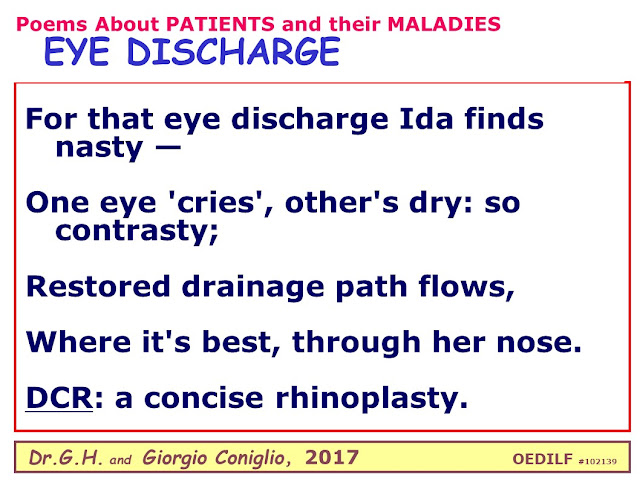This post is a continuation of "PATIENTS and their MALADIES, part #1", as posted on this blog in March 2021.
previous poetic posts (part #1)
amblyopia
bph (benign prostatic hypertrophy)
brain symptoms (post-concussion)
common cold
Conn's syndrome (aldosterone excess)
claudication
diabetes insipidus dyspareunia
CURRENT CONTENTS:
Eye discharge
Flu-like symptoms
Ganglion cyst
Gluten sensitivity
Graves disease
Gynophobia
Hemorrhoids
Hemiplegia
(for continuation, see the link below)
dacryocystorhinostomy: a surgical procedure used to relieve lacrimal obstruction (blocked tear drainage)
DCR: abbreviation for above, used by surgical ophthalmologists, who usually perform the procedure
Authors' Note: These common small limb lesions that may fluctuate spontaneously are most often found at the wrist. The name ganglion, Greek for "knot", is a misnomer, as examination by ultrasound or aspiration shows that they are thin-walled cysts filled with synovial (i.e. joint) fluid — such testing is not needed in most cases. Incidentally, the term tumour is a synonym for "growth" or "lump"; health professionals avoid using the term in dealing with lesions that have no oncologic significance in order to allay unnecessary patient anxiety.
Authors' Note: Celiac disease (also spelled coeliac), is a classic gastrointestinal disease characterized by poor absorption of nutrients and wasting, that is caused by sensitivity to gluten, a composite of two storage proteins that are found extensively in certain cereal grains. Diseases involving other body systems have also been described even in the absence of the classic GI symptoms. For uncertain reasons, there has been a recent dramatic increase in a less severe but contentious problem referred to as non-celiac gluten sensitivity, whose treatment is the same as for the classic disease, i.e. elimination of sources of gluten from the diet.
We have discussed this type of food intolerance, among others in a longer poem that you can review HERE.

Authors' Note: Graves' disease (often shortened by medical types to the ominous-sounding Graves' ), described by Robert Graves in 1835, is a common auto-immune disease that attacks the internal controls in the thyroid gland, and results in the overproduction of thyroid hormones. Significant symptoms result from hyperthyroidism, the hypermetabolic state that is produced.
Among several effective treatments, antithyroid drugs, taken over months or years, block production of these hormones, and often result in resumption of the euthyroid (normal) state.

Authors' Note:
pro tem: frequently used short form for the Latin 'pro tempore' -- for the time being, in the short term.
Readers might also enjoy a verse on the same part of the anatomy presented in September 2021 in the collection "The Bottom Line of Medical Humor". Click HERE.
Authors' Note: In medical jargon, a stroke (cerebro-vascular accident) that leaves the victim with complete loss of function in the affected area is said to be dense. Patients like old friend Dave, who have had a dense stroke with severe one-sided weakness (hemiplegia) in mid-life, may survive with appropriate early treatment of atherosclerotic lesions in the opposing carotid artery and other major arteries, to prevent further loss of function. With appropriate physiotherapy, targeted at flexibility in the affected area and strength on the unaffected side, such patients can get through several decades, walking hesitatingly, with the use of canes and other assistive devices. As these courageous persons age, mobility issues become even more problematic than for the rest of us.
Requests from many health professionals, and layfolks as well, have come to fruition; there is now another followup post continuing this theme that you can easily access. Click HERE for part #3 of 'Patients and their Maladies'.
GENERAL DIRECTIONS FOR WEB-EXPLORERS:
To resume the sequence of daily titillations on our related blog "Daily Illustrated Nonsense", click HERE. Once you arrive, you can select your time frame of interest from the calendar-based listings at the bottom of the page, and check the daily offerings for any month from the start of 2020 until December 2024.
As of December 2024, there are 1800 unique entries available on the daily blog, displaying individual poems (often illustrated) and wordplay, but also with some photo-collages and parody song-lyrics. Most of their key elements are also presented here on "Edifying Nonsense" in topic-based collections, such as this one. The "Daily" format also has the advantage of including some song-lyrics, videos and other material that are not shown here on this topic-based blog.








No comments:
Post a Comment